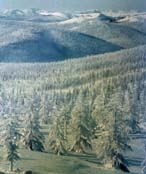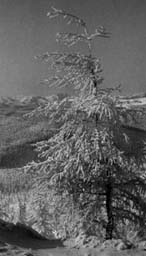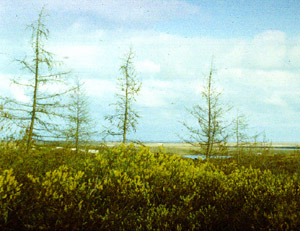
Vast forest of one species, in the Oymyakon Basin, Yakutia [Vladimir Dinets].

Tree in the Oymyakon Basin, Yakutia [Vladimir Dinets].
![]()
Open forest-tundra stand, Oymyakon Basin, Yakutia [Vladimir Dinets].

The world's northernmost forest, of 'Larix cajanderi' at Ary-Mas, Taimyr
Peninsula. There are 2 isolated groves, separated
from the timberline by 200 km of tundra [Vladimir Dinets] (5).
Common Names
Dahurian larch; Listvennitsa daurskaya [Russian]; Luoye song [Chinese]; Gui-natsu [Japanese] (1).Taxonomic notes
Syn: Abies gmelini Rupr.; Larix dahurica Turcz. ex Trautv.; L. kamtschatica (Endl.) Carrière; L. sibirica Maxim. non Ledeb.; L. amurensis hort. in Beissn., pro syn.; L. cajanderi Mayr; L. dahurica var. pubescens Patschke; L. dahurica var. prostata Regel; L. dahurica f. macrocarpa Liou & Wang; L. dahurica f. glauca Liou & Wang; L. dahurica f. denticulata Liou & Wang; L. komarovii Kolesn.; L. ledebourii (Rupr.) R. Tsinovskis; L. middendorfii Kolesn.; L. ochotensis Kolesn.; L. gmelinii var. hsinganica Yang & Chou; L. heilingensis Yang & Chou (1).Where the two species are distinguished (as they often are in Russia), L. gmelinii s.s. occurs from central Siberia E to about longitude 120°E to 125°E, which area comprises a zone of hybridization with L. cajanderi, which occurs in nearly all of forested Siberia E of longitude 125°E.
"Larix gmelinii and L. cajanderi do not differ in either qualitative morphological features or quantitative measurements. There is both geographical and ecological isolation between them. Larix cajanderi grows in more rigorous ecological conditions than L. gmelinii... [D]ifferences in the qualitative characteristics are gradual and are probably caused by clinal variation" (6).
Most of the synonyms listed above reflect variation encountered between E Asian populations. For example, "Larix heilingensis Yang & Chou has been described from the low mountains east of Harbin (Heilongjiang) in NE China ( Yang, Chou & Nie, 1964 ). Its strongly pubescent seed scales seem to be the most striking feature, but this pubescence is also present in some (young) cones from other parts of the range and is a very variable character. Cheng & Fu 1978 treated it as a synonym of L. olgensis Henry, but its cones (judging from Chinese drawings and descriptions, specimens not seen) are much smaller and very much unlike Henry's type. Other very minor differences with L. gmelinii and L. olgensis, as tabulated by Yang, Chou & Nie (1964) are all within the variations found in the typical variety of L. gmelinii, so it seems appropriate to treat L. heilingensis Yang & Chou as a synonym of L. gmelinii (Rupr.) Rupr." (1).
Along its western margin, the range of L. gmelinii is contiguous with that of L. russica, with which it readily hybridizes to form L. x czekanowski (7).
Farjon (1) distinguishes three varieties (besides the type) of L. gmelinii, all occurring in E Asia:
(1) Larix gmelinii var. japonica (Regel) Pilger
(2) Larix gmelinii var. olgensis (Henry) Ostenf. & Syrach Larsen
(3) Larix gmelinii var. principis-rupprechtii (Mayr) Pilger
Description
See (1).Range
Russia: the typical variety occurs in E Siberia, Sakhalin, the inner valley of Kamchatka, NE Mongolia; NE China (in the Hinggan Ranges) and Korea, with an isolated population in Kamchatka (1, 4). The varieties are generally found in SE Russia, the Kuril Islands, and China N and E from Shanxi (1).Big Tree
Pyaktusan Mt. on China-Korea border (46 m tall) (4).Oldest
544 years, verified (except the first few decades) by crossdating (8).Dendrochronology
Has only recently been investigated. Work to date includes an exploratory study (2) and three chronologies with climate reconstruction (3, 8, 9).Ethnobotany
Observations
Remarks
Citations
(1) Farjon 1990.(2) Osawa 1993.
(3) Earle, Christopher J., Linda B. Brubaker, Andrei V. Lozhkin and Patricia M. Anderson. 1994. Summer temperature since 1600 for the upper Kolyma region, northeastern Russia, reconstructed from tree rings. Arctic and Alpine Research 28(1).
(4) Vladimir Dinets, e-mail communication, 2-Jan-1998.
(5) Vladimir Dinets, e-mail communication, 3-Feb-2000.
(6) Milyutin & Vishnevetskaia 1995.
(7) Schmidt 1995.
(8) G.M. MacDonald, R.A. Case and J.M. Szeicz. 1998. A 538-year record of climate and treeline dynamics from the lower Lena River region of northern Siberia, Russia. Arctic and Alpine Research 30: 334-339.
(9) S.G. Shiyatov, V.S. Mazepa, E.A. Vaganov and F.H. Schweingruber. 1996. Summer temperature variations reconstructed by tre-ring data at the polar timberline in Siberia. P.61-70 in Dean et al., Tree Rings, Environment and Humanity. Radiocarbon 1996. Tucson: University of Arizona Department of Geosciences.
See also:
Sakai, A. and M. Saito. 1974. Dahurian larch trees in Yakutia. Journal of the Japanese Forestry Society. 56:247-252 [In Japanese, with English abstract].
Uemura, Shigeru, Satoshi Tsuda and Sakae Hasegawa. 1990. Effects of fire on the vegetation of Siberian taiga predominated by Larix dahurica. Canadian Journal of Forest Research 20:547-553.
Larix | Pinaceae | home
This page is from the Gymnosperm Database
URL: http://www.geocities.com/~earlecj/pi/la/gmelinii.htm
Edited by Christopher J. Earle
E-mail:
earlecj@earthlink.com
Last modified on 6-Feb-2000